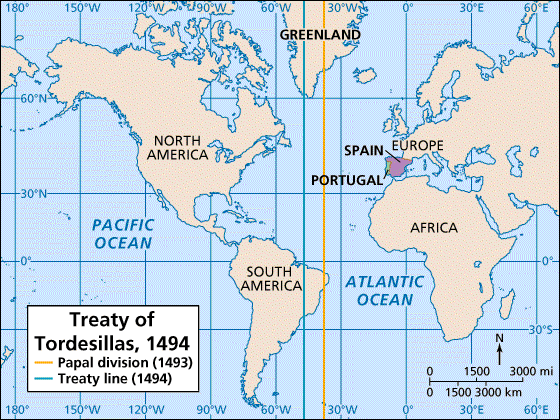Spain in the New World
Part 1: First Explorations Spain had a wide-ranging number of colonies in the New World, in both North America and South America, for more than 400 years. The first Spanish explorer to reach the New World was an Italian sailor. Christopher Columbus, who was from Genoa, sailed under a Spanish flag in 1492 on his historic voyage, making landfall in Hispaniola, returning to tell about it, and setting off a wave of exploration that filled the coffers of various European powers for many generations. Spain's Catholic Monarchs, Ferdinand and Isabella, had encouraged Columbus to pursue his voyage and certainly benefited from what he brought back. In fact, Columbus made four voyages to the New World in all. 
In 1494, the joint rulers signed an agreement with King John II of Portugal to divide ownership rights of New World territory between the countries. This was the Treaty of Tordesillas, agreed to on June 7, 1494. This was, in fact, a pronouncement by Pope Alexander VI that drew a north-south line on the map and divided North America and South America between Spain and Portugal. In reality, most of the New World was west of the line and so Spain ended up getting nominal authority over much more territory than Portugal did. Some of Columbus's men had stayed behind, founding the colony of Natividad on Hispaniola. When Columbus returned, he found the colony empty. The Spaniards had tried to take over the area and had been killed by the natives. Columbus founded another colony east of Natividad, naming it Isabela. He traveled around Cuba and Jamaica, then decided to return home again. His brother Batolome stayed behind on Hispaniola and founded Santo Domingo, the first permanent European settlement in the New World. Columbus arrived back in Spain in 1496. 
There wasn't much chance of a third voyage until Portugal's Vasco da Gama landed in India in 1497. Spain quickly wanted to catch up, so it sent Columbus back to the New World with six ships. They arrived on the island of Trinidad in July 1498 and then traveled on to the mainland, discovering South America. Columbus sailed back to Santo Domingo and found more trouble with Spaniards left behind. A royal commissioner from Spain soon arrived, blamed Christopher and Bartholomew Columbus for the trouble, and had them both arrested and put in chains and then sent home in disgrace. The fourth and final voyage of Columbus came in 1502, after he had regained the monarchs' favor. He sailed to the island of Martinique and then to Honduras, in Central America. After more exploring in the Caribbean, Columbus returned home to Spain, in 1504. |
|
Social Studies for Kids
copyright 2002–2025
David White




